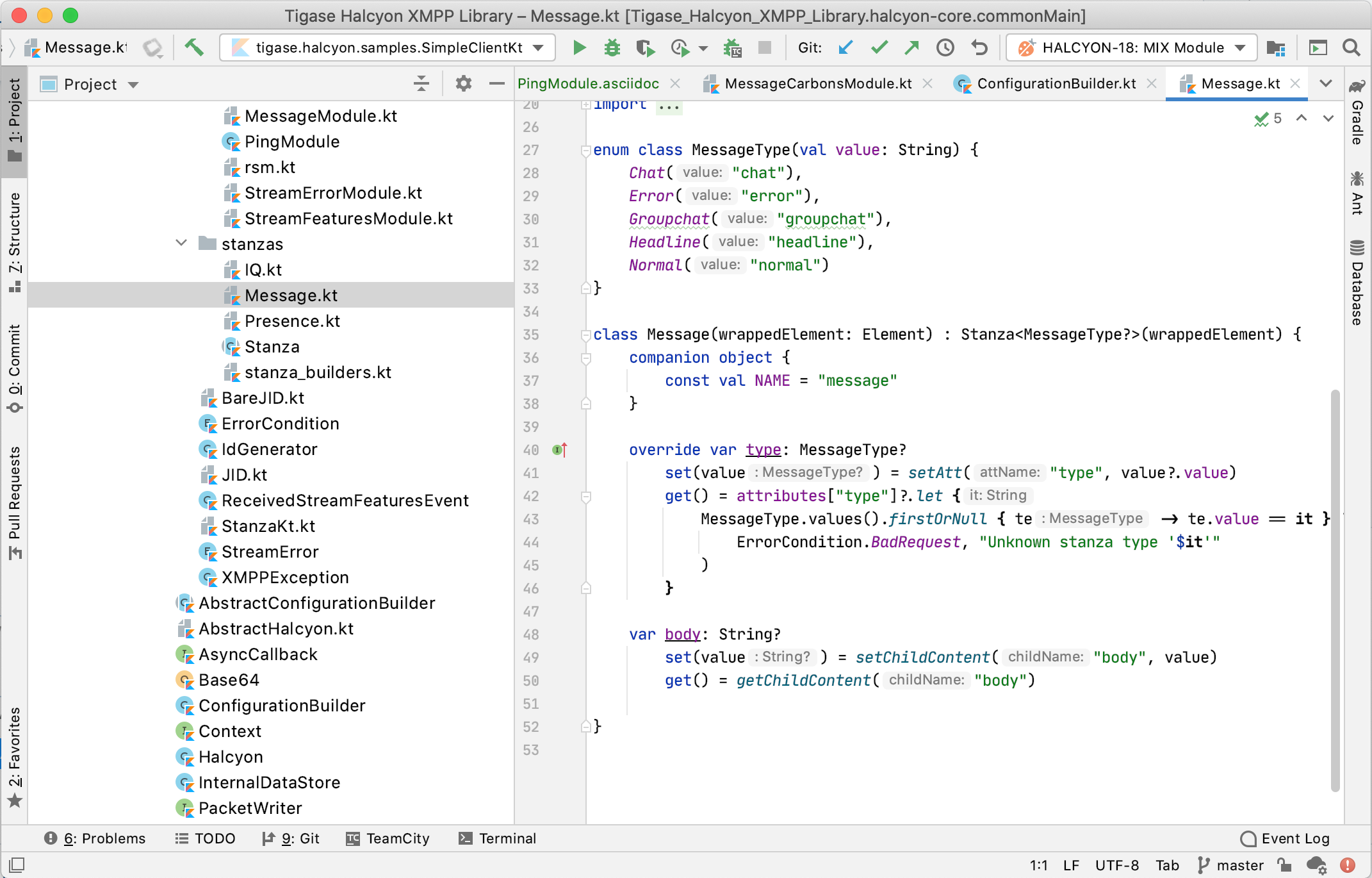New XMPP library written in Kotlin with multiplatform goals.
A look at Halcyon
Some time ago, we started developing multiplatform XMPP Library called Halcyon based on Kotlin Multiplatform by Jetbrains. Our plan is to allow using the same library in different target environments: JVM, Android, JavaScript and Native. Currently we are focused on JVM and JavaScript targets.
In this post we will try to show library design and example of usage.

Before you start
Because Halcyon isn’t published in any Maven repository (yet), you need to compile it yourself. We believe, it will not be a problem. The only two things you need to do is to clone repository and compile library:
```shell script git clone https://github.com/tigase/halcyon.git cd halcyon ./gradlew publishToMavenLocal
Thats all. Now Halcyon is in your local Maven repository.
## Let's do something
We recommend using Gradle to build everything (except for towers and bridges maybe). You can also use Maven, it doesn't matter. Just use one of them, to prevent problems with dependencies.
Here is sample `build.gradle.kts` file, the most important this is to enable kotlin plugin and include Hayclon in the list of dependencies:
```kotlin
plugins {
java
kotlin("jvm") version "1.3.61"
}
repositories {
mavenLocal()
jcenter()
mavenCentral()
}
dependencies {
implementation(kotlin("stdlib-jdk8"))
implementation("tigase.halcyon:halcyon-core-jvm:0.0.1")
testCompile("junit", "junit", "4.12")
}
configure<JavaPluginConvention> {
sourceCompatibility = JavaVersion.VERSION_1_8
}
tasks {
compileKotlin {
kotlinOptions.jvmTarget = "1.8"
}
compileTestKotlin {
kotlinOptions.jvmTarget = "1.8"
}
}
Let’s add some Kotlin code:
fun main(args: Array<String>) {
val client = Halcyon()
client.configure {
userJID = "user@sampleserver.org".toBareJID()
password = "secret"
}
client.connectAndWait()
client.disconnect()
}
This simple code creates XMPP client, connects to XMPP server and then disconnects.
To show how to work with Halcyon library, we will by adding code to this small code base.
Events
Halcyon is events-driven library. It means, that each part of library may publish event to event bus and all registered listeners will receive it.
Lets add some code to see what is being send and received over XMPP stream:
client.eventBus.register<ReceivedXMLElementEvent>(ReceivedXMLElementEvent.TYPE) { event ->
println(">> ${event.element.getAsString()}")
}
client.eventBus.register<SentXMLElementEvent>(SentXMLElementEvent.TYPE) { event ->
println("<< ${event.element.getAsString()}")
}
To listen for all events since the connection is started, we have to add this code before client.connectAndWait().
All events extend class tigase.halcyon.core.eventbus.Event, so you can easily find them all in your favourite IDE.
Each module may have it’s own set of events, so please check documentation or source code of modules of interest.
Request
Now we will look at one of the most interesting things in XMPP: requests and responses.
XMPP protocol allows sending request to another entity and receive response. Why is it so exciting? Because we can ping other clients, or ask for their local time! Ok, stop joking. Of course above examples are true, but with request-response we can do much more than simple sending messages: we can manage our contacts list, we can manage Multi User Chatrooms, we can execute remote methods on server or other clients.
As an example we will ping other XMPP entity (it may be server or other client).
First we need to get PingModule to be able to use its request builder:
val pingModule = client.getModule<PingModule>(PingModule.TYPE)!!
Ping module has method ping() which creates a request builder (note, that it doesn’t send anything yet!) configured to understand response and return it as object.
Method ping() has optional parameter jid. If is not provided, then ping will be send to the server to which the client is connected.
val request = pingModule.ping()
request.response { result ->
when (result) {
is IQResult.Success -> println("Pong in ${result.get()!!.time} ms")
is IQResult.Error -> println("Oops! Error ${result.error}")
}
}
request.send()
There is also a different way to add response handler to the request:
request.handle {
success { request, iq, result -> println("Pong in ${result!!.time} ms") }
error { request, iq, errorCondition, message -> println("Oops! Error $errorCondition") }
}
Use the one that you prefer.
One more example: we will check list of features of our server:
val discoveryModule = client.getModule<DiscoveryModule>(DiscoveryModule.TYPE)!!
discoveryModule.info("sampleserver.org".toJID()).handle {
error { request, iq, errorCondition, message -> println("Oops! Error $errorCondition") }
success { request, iq, result ->
println("Server JID: ${result!!.jid}")
println("Features:")
result!!.features.forEach { println(" - $it") }
}
}.send()
Messages
This chapter will be very hard, mostly because MessageModule isn’t finished yet.
We haven’t made a design decision yet - how this module should work. It is good for you though, because we can create message stanza from scratch! And it’s cool!
This is how message stanza look like:
<message
from='juliet@example.com/balcony'
id='ktx72v49'
to='romeo@example.net'>
<body>Art thou not Romeo, and a Montague?</body>
</message>
Let’s try to create this stanza in Kotlin and send it.
var messageRequest = client.request.message {
to = "romeo@example.net".toJID()
body = "Art thou not Romeo, and a Montague?"
}
messageRequest.send()
The only thing currently implemented in MessageModule is MessageReceivedEvent, useful to handle all incoming message stanzas:
client.eventBus.register<MessageReceivedEvent>(MessageReceivedEvent.TYPE) { event ->
println("Message from ${event.fromJID}: ${event.stanza.body}")
}
Roster and presence
Ok, we can send a message to anybody, but most of the time we want to send them to our friends. We need a list of our friends. Luckily such list is available out-of-box in XMPP protocol: it is called Roster.
It shouldn’t be a surprise, but to manage your roster you need RosterModule:
var rosterModule = client.getModule<RosterModule>(RosterModule.TYPE)!!
We can add (or update, with the same method) roster items, remove and list them.
val allRosterItems = rosterModule.store.getAllItems()
RosterItem contains JabberID of the contact, list of groups being assigned to, status of subscription (if contact is allowed to see our presence or not, and if we are allowed to see it’s presence).
Presence is “status of contact”. You can see if your contacts are online, offline or maybe you shouldn’t send any message to someone because he has “Do Not Disturb” status.
As an example, we will list all contacts from the roster and their presence:
rosterModule.store.getAllItems().forEach { rosterItem ->
val presenceStanza = presenceModule.getBestPresenceOf(rosterItem.jid)
println("${rosterItem.name} <${rosterItem.jid}> : ${presenceStanza?.show ?: "Offline"}")
}
Thanks…
…for being here up to this point. We hope you enjoyed reading about Halcyon library, and you liked it even though it is not finished yet.
Please share you thoughts and ideas at our group chat tigase@muc.tigase.org or on library GitHub page.
